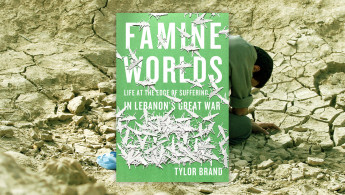How WWI caused the 1915 Great Famine of Mount Lebanon
The Great Famine of Mount Lebanon in 1915 was perhaps among the most shocking during the First World War.
However, it is afforded little attention when discussing the immense suffering of that period and over 100 years on we are still trying to make sense of it.
For many not directly caught up in the fighting, the famine was the worst experience of the whole war.
"Making sense of the suffering during the Great Famine of Mount Lebanon is a key part of studying history and hopefully, more will engage with it"
A new book by Tylor Brand Famine Worlds: Life at the Edge of Suffering in Lebanon’s Great War illuminates aspects of this seminal and devastating experience in a highly engaging and readable way.
As Brand reminds us all famines are different and no two famines are the same, “Famine is not necessarily defined by a lack of food so much as it is by people’s inability to acquire it in sufficient quantities. In the wartime famine, access to food was hampered by rising prices, but it was exacerbated by unemployment, underemployment, and inadequate wages due to both currency collapse and stagnant salaries.”
|
The death toll was likely high although Brand cautions us about trusting death tolls being cited as being more akin to guesses rather than empirically verifiable information.
He also points out that “suffering in famine does not necessarily correlate with death. In even the worst famines, the vast majority of people survive, and famines with relatively low mortality can still be filled with terrible suffering.”
The other issue is that there are several different death tolls in circulation and reading primary literature from the time does not give us a good indication of where the true number lies.
What the different numbers do convey, Brand says, is the sense of widespread suffering and its severity. Another thing Brand observes in the famine literature from the time is that each region of Lebanon assumes they have a higher death toll than neighbouring regions and thus are being made to suffer more. This assertion demonstrates the divisions at play even during this crisis.
The causes of the famine are multi-varied and include the Ottomans' decision to join the First World War, Istanbul’s decision to close ports in Syria, the allied blockade of the empire, locusts attacking crops, conscription of working-age men, unemployment caused by the blockade and other issues.
Strategies of survival during the famine varied too, there is a tendency to focus on the extremes and abhorrence of human behaviour during the Lebanon famine, whether it's tales of cannibalism, criminality and prostitution. This unfairly colours our view of survival during the Great War.
"Famine Worlds is a much-needed and deeply insightful read on the Great Famine, the Levant region and how the Ottoman Empire suffered greatly during this turbulent period"
Brand reminds us as awful as these listed behaviours were, “they were often the final choices at the end of a long line of adaptive strategies.” However, there was a wide range of adaptive strategies adopted at the time, which are overlooked by people today as they do not involve these extreme behaviours. Intense focus on these methods leads to an inaccurate view of how people survived.
Muhsin Al-Amin, a Shia sheikh, responded to the crisis by selling his belongings and food reserves and leaving his Lebanese village for Damascus.
When Damascus proved to be a bad choice, he moved back and used what little resources he had left to buy animals and he was able to feed his family throughout the war.
The different choices he made reflect adaptive strategies to changing circumstances, Al-Amin starts doing things he would never imagine, but these more ‘mundane’ adaptations are a key part of the famine story. Another common adaptive strategy was changing food receipts in line with what was available.
|
Famine Worlds is a much-needed and deeply insightful read on the Great Famine, the Levant region and how the Ottoman Empire suffered greatly during this turbulent period.
A lot of taboos and mythologies have built up around it, however, what Tylor Brand offers is an opportunity to interrogate these myths, he also offers us a chance to interrogate our assumptions and understanding of events like famine.
While no two famines are alike, there is a common link in terms of how people think they unfold and reading Famine Worlds will arm the reader with new questions to probe into other famine histories.
You don’t need to be an expert on the history of the Lebanon famine or of famines, in general, to take a lot away from this book. Indeed it is written with the general reader in mind. That does not mean experts in the history of famine cannot take anything away from this book- it will be of interest to specialists and non-specialists alike.
Making sense of the suffering during the Great Famine of Mount Lebanon is a key part of studying history and hopefully, more will engage with it.
Usman Butt is a multimedia television researcher, filmmaker and writer based in London. Usman read International Relations and Arabic Language at the University of Westminster and completed a Master of Arts in Palestine Studies at the University of Exeter.
Follow him on Twitter: @TheUsmanButt



